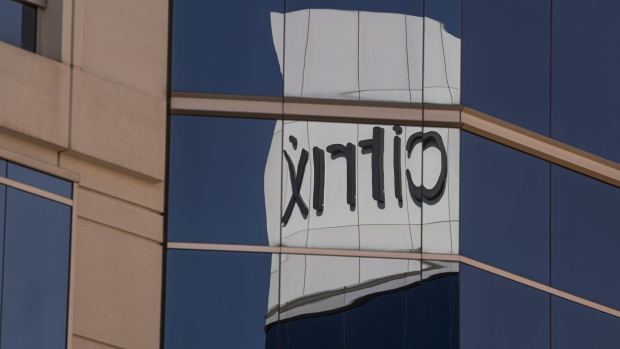Aug 15, 2022
With Junk Debt Proving Hard to Shift, Banks Try Rebranding Their Loans
, Bloomberg News

(Bloomberg) -- Banks are rebranding a chunk of their loans, a move that allows them to keep the debt on their balance sheets in order to mop up some of the $80 billion of underwritten debt flooding the public debt markets.
A $15 billion debt financing for tech firm Citrix is one of the latest deals expected to adjust its capital structure, enabling the arranging banks on the deal to cut the amount of loans earmarked for institutional investors. That follows a similar move taken by banks for deals including Inetum, 888’s buyout of William Hill’s international assets, and Wm Morrison Supermarkets.
As the economic outlook has darkened throughout 2022, banks have been unable to sell billions of dollars in leveraged loans underwritten as so-called term loan Bs, a relatively risky type of debt typically sold to institutional investors. In an effort to reduce the amount available, banks are converting a portion into term loan As, a safer category of debt held by the lenders themselves. But market participants are struggling to spot the difference.
“In some cases they are identical to the TLB,” said Ben Thompson, head of EMEA Leveraged Finance Capital Markets at JP Morgan. “In other cases, they could have a slightly shorter tenor or have a bit of amortization to make them more palatable but by and large they will feel, if not exactly the same as a TLB then like a TLB, rather than a TLA.”
New TLAs
Many of these new term loan As are still seven-year, covenant-lite, bullet repayment loans -- the characteristics usually associated with term loan Bs, as opposed to five-year, covenanted, amortizing loans traditionally seen on TLAs.
Despite the rebranding, banks are still on the hook to provide the terms they underwrote the loans on, unless they can renegotiate with the sponsors.
Some will allow banks to adjust the length of the maturity to a so-called 5+1+1, so they look at the outset like a five-year loan, more akin to a term loan A. However, the expectation is that the additional two-years will be at the sponsor’s discretion, as opposed to the banks’. Some might also agree to a small amount of amortization, such as 2.5% to 5% per annum.
Different banks are treating these term loan As differently. While some commercial banks, with the ability to hold paper, are seeing an opportunity to hold on to higher-yielding paper, other lenders will be looking to offload the paper as soon as market conditions improve.
Traditional Instruments
Given reduced liquidity, there will still be some term loan As come to market that are more like the traditional instruments, especially in the case of safer loans to better-rated companies such as a 4 billion euro term loan A for the Orange and Masmovil telecoms deal.
However, these will be reserved for new deals as opposed to the conversion of stagnant term loan Bs.
In the meantime, however, the hope for bankers is that reducing the pool of riskier debt available will make the remaining loans more attractive for investors.
“The loan market is in a tight spot from a liquidity point of view, and the ability to absorb any sort of large size is really challenging,” Thompson said. “The banks are trying not to swamp the market with offerings that are too big to be absorbed.”
Elsewhere in credit markets:
EMEA
The risk of a euro-area recession has reached the highest level since November 2020, according to economists polled by Bloomberg, adding to expectations of low activity across the region’s debt market on Monday.
- There are two deals being offered in Europe’s primary market on Monday, including a sterling tier 2 note from Svenska Handelsbanken
- Europe’s primary market participants are forecasting at least another week of subdued issuance activity, according to a survey conducted by Bloomberg News on Aug. 12
- Sparebanken Sor is considering a potential new perpetual Additional Tier 1 bond issue of NOK200m
- While issuance is expected to remain limited, the success of Europe’s few corporate debt deals over the past month may galvanize other issuers to bring surprise sales to market during the traditionally slow summer months
Asia
Asia got global credit markets off to strong start of the week, extending one of the best rallies this year, after an unexpected interest rate cut in China.
- Goldman Sachs strategists have shifted to a neutral stance across Asian investment-grade and high-yield bonds, from an earlier preference for IG, citing a reduced risk of a near-term recession in the US and improved valuations for high-yield
- Chinese developer Longfor Group Holdings Ltd. will receive a HK$3.5 billion ($447 million) syndicated loan, according to a person familiar with the matter, potentially alleviating market concern about its liquidity
- An onshore bond from Chinese developer KWG Group Holdings Ltd. fell by an almost record amount for the second time in less than a week on Monday, as the deadline for investors to exercise a put option arrived
Americas
Major Wall Street banks including JPMorgan Chase & Co, Barclays Plc and Citigroup Inc. are offering to facilitate trades in Russian corporate debt and government bonds, according to Reuters.
- Wall Street banks are expected to start talks afresh with investors on Monday to sell parts of a $15 billion debt financing for the buyout of software company Citrix Systems Inc., at a time when sales activity will generally be quiet
- Altera Infrastructure LP, an offshore energy services provider owned by affiliates of Brookfield Asset Management, filed for Chapter 11 bankruptcy protection in Houston
- In high-yield, the primary market is expected to remain quiet this week with the expectation of a few drive-by bond sales next week
(Updates with latest news on global credit markets)
©2022 Bloomberg L.P.




